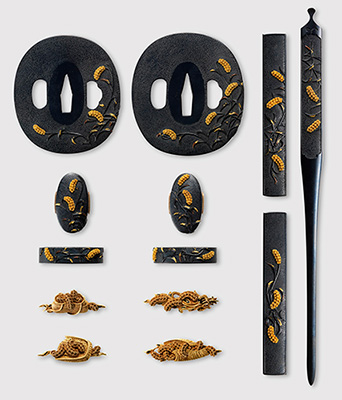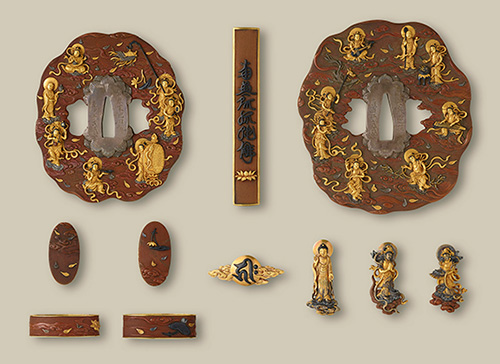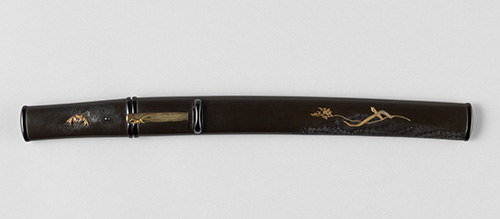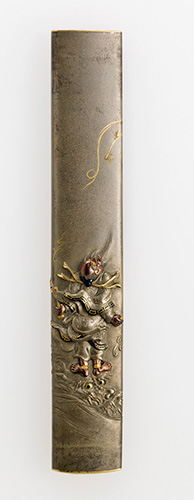
Set of Sword Fittings with Millet Design by Araki Tomei
Edo period (19th century): held formerly in Mitsumura Toshimo’s collection and now in a private collection

Katana Sword by Gassan Sadakazu
1905: held formerly in Mitsumura Toshimo’s collection and now in the collection of the Nezu Museum

Mitsumura Toshimo conducted business mainly in Osaka and Kobe. For this reason, he patronized an Osaka-based swordsmith, Gassan Sadakazu (1836–1918) and ordered many works from him. This item was ordered by Mitsumura to commemorate the victory of Japan at Port Arthur in the Russo-Japanese War, and the sword is characterized by flamboyant decorations densely carved on both sides, which may be a reflection of Mitsumura’s design preferences.
Set of Two Sword Fittings with Descending Buddha and Bodhisattvas Design by Goto Ichijo: Important cultural property
1824–1825: held in a private collection

A masterpiece of Goto Ichijo (1791–1876), a metalsmith of Kyoto, this set is being shown publicly for the first time in 40 years. The gold Bodhisattvas on the red-colored copper background make these sword guards impressively exquisite. They were ordered by Nakai Takenari, a wealthy merchant in Kyoto and descendant of the family of Omi merchants, and owned by the Nakai Family during the Meiji period. Mitsumura selected these works to be on the first page of volume one of Tagane no Hana, which is a luxurious book that he published. The fact that Mitsumura prioritized a masterpiece held by another family over any work of his own collection indicates his impartial attitude regarding the appreciation of beauty.
Lacquered Dagger Mounting with Wave and Reed Design by Kano Natsuo and Shibata Zeshin
Edo period (19th century): held formerly in Mitsumura Toshimo’s collection and now in the collection of the Nezu Museum

The hilt and scabbard of this mounting are meant to resemble a sandy beach and sea respectively, while the menuki (ornamental piece on the hilt) is used to represent a crab on a rocky area; ocean waves are portrayed by means of the wave-patterned seigaiha-nuri lacquering. This gorgeous work was created through the collaboration of two great artists: Kano Natsuo (1828–1898), a metalsmith, and Shibata Zeshin (1807–1891), a lacquerer, who were both active from the end of the Edo period to the Meiji period.
Small Knife Handle with Lu Dongbin Design by Tsukada Shukyo
Years 30–39 of the Meiji period (1897–1906): held formerly in Mitsumura Toshimo’s collection and now in the collection of the Nezu Museum

The handle has an inscription that reads “Made by Shukyo after an order from Mitsumura Toshimo (gold seal).” Many of the sword fittings ordered by Mitsumura use famous paintings as motifs, as does this piece. The motif of this ambitious work is an ink painting by Sesson from the 16th century, titled Lu Dongbin, a Chinese immortal, carved on the metal surface. The composition and figure are a precise reproduction of the original painting by Sesson, except for the redness of his face, which is considered to be the idea of Shukyo.

Araki Tomei (1817–1870) was a sword fitting maker active in Kyoto at the end of the Edo period, and is known for inventing a method for carving designs of ripe millet. Among Tomei’s numerous works with millet designs, this set of sword fittings is regarded as being especially representative of his work due to the bright golden millet on the jet-black gold-copper alloy background.